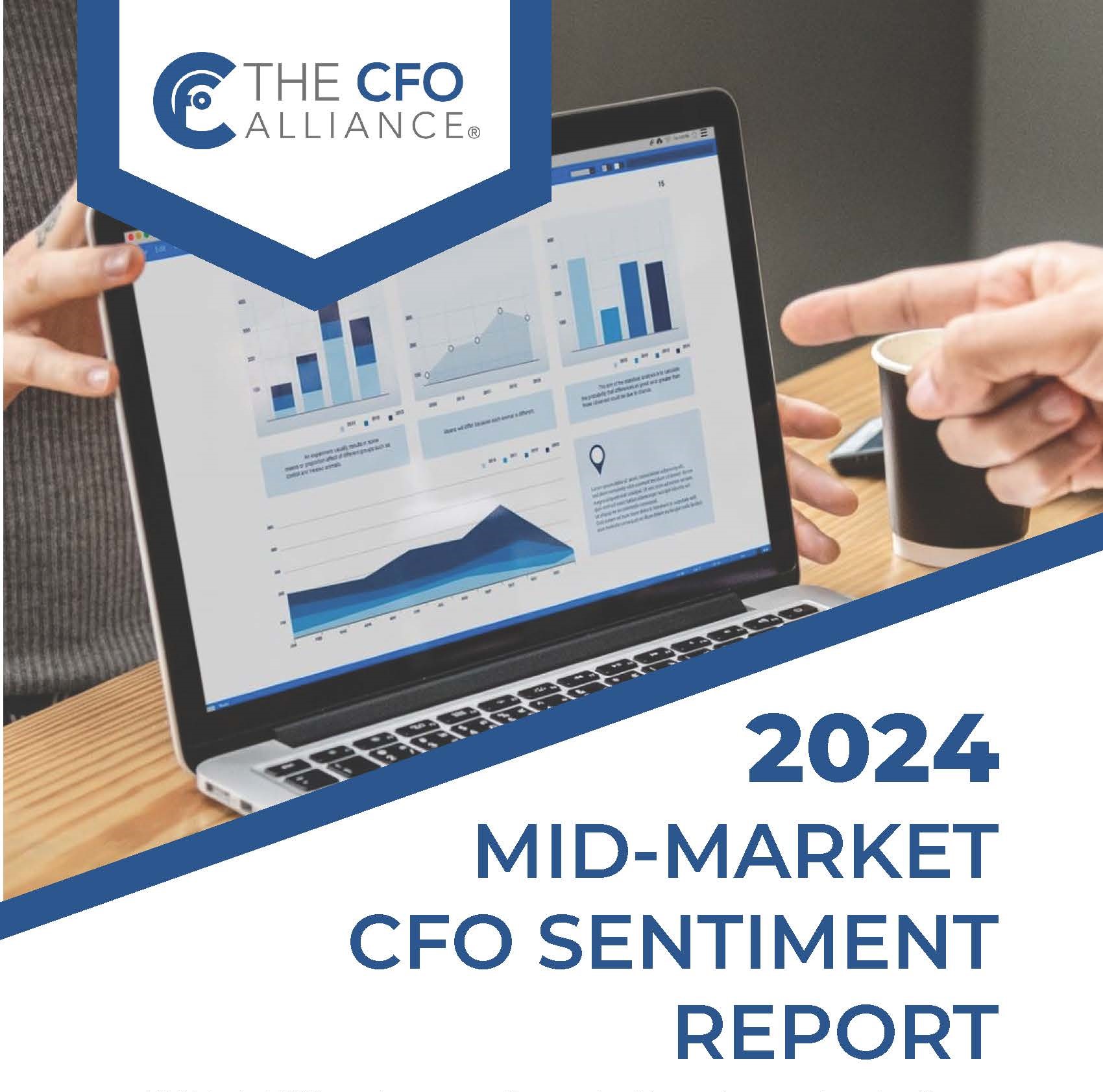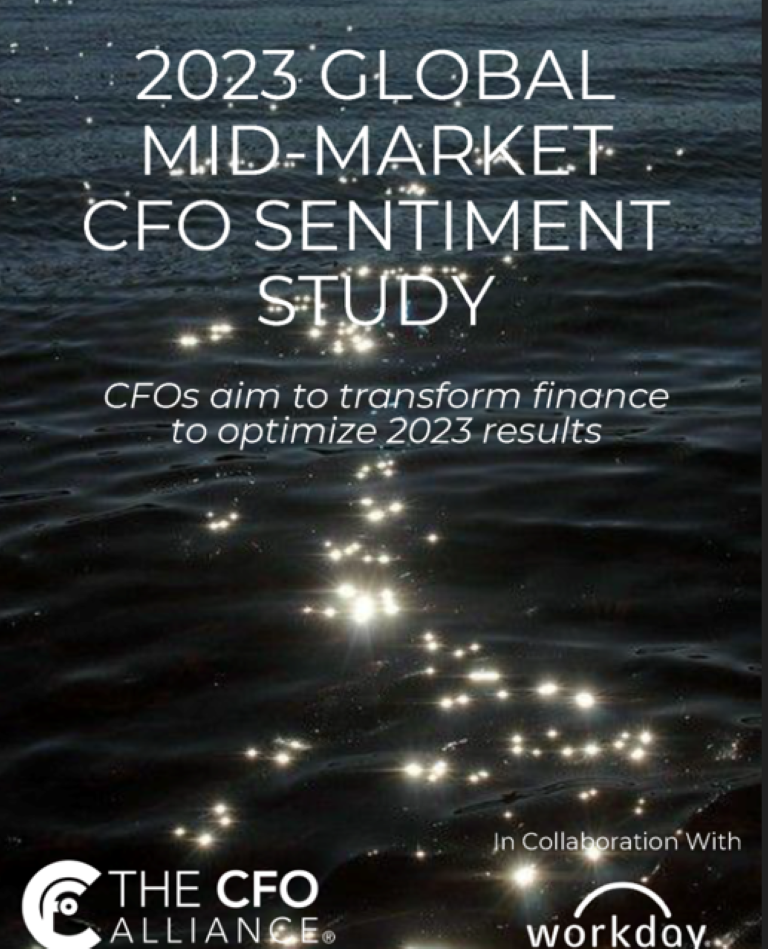A CFO’s Quick-start Guide to Diagnosing Top Line Shortfalls - PART 2
In Part 1, top line growth was referred to as “the elephant in the room” during 2023. Growth plans faced an uphill battle right out of the gate at year-start. With the ball dropping at midnight in Times Square on the 31st, how and to what extent do we expect business conditions and performance to change over 2024?
What Will It Be: Economic Head Winds? Calm? or Tail Winds?
The trends and underlying forces supporting all answers are soft, sketchy, and vacillating. The data rationalizing any predictions is often contradicted by other data and interpretations – sometimes within the same day. And too many factors have to come right to make answers bankable.
This is precisely why The CFO Alliance is focusing on growth as an integral component of our Focus on Finance. In the end, Finance is about building efficient growth engines. This 2-part article series leans into key principles enabling Finance to coach internally and ensure growth.
Understanding what makes or doesn’t make growth happen is so key to the CFO’s success formula that there’s a case for arguing it’s more important than any other aspect of the role. A goodly number of CEOs and business owners would back that idea. It at least ranks right up there with cost management.
Especially today, CFOs need a “true North” compass that sets growth expectations correctly. And without a better understanding the growth calculus, it’s safer to ride the brakes. The downside of brake-riding is the possibility of missing the upside. A “running in place” posture just doesn’t feel right regardless of economic uncertainty. Conversely, seeing the playing field as half-full inspires opportunism even in our present-day chaos; it just takes smarter fundamentals and will, neither of which are trivial. But “Winning is not a sometime thing; it’s an all-the-time-thing”. (Vince Lombardi).
Problem-solving for Growth
Part 1 on the topic of top line growth analyzed the major revenue growth challenges identified by CMOs in a recent Gartner survey. In Part 2, we’ll go further into the survey findings and analyze the actions CMOs plan to take to fix their challenges. Just as in Part 1, the findings are telling. And they are relevant to businesses large and small, and span a spectrum of major industries.
For convenience, here’s a quick refresher from Part 1 on the growth challenges identified in rank order:
- Competition (51%)
- Determining Market Fit and Strategy Complexity (43% each)
- Building the Ideal Customer Profile (40%)
- Conveying Value Proposition (31%)
- Measuring Success (28%)
- Internal Stakeholder Mis-alignment (23%)
Part 1 offered perspectives about what these challenges revealed, the root causes, and ways to act on them.
This Part 2 diagram illustrates what CMOs plan to change. Prescriptive commentary that follows on these changes could vary depending on what was already provided in Part 1. So, some of the commentary will direct the reader back to Part 1, as needed.
Getting Inside the Changes
Leading the pack at 63% of change mentions is Clarify Value Proposition. This is the most basic aspect of a marketing strategy, and it’s nothing short of alarming to see how broken it must be. If marketing doesn’t know who receives higher than average value from the product’s advantages, and if they can’t define what the product does uniquely better and what better is worth, it screams “Houston, we have a problem” . . . as in customer profile data and skills problems, and the possibly of product fit problems.
Solving this requires a peel-the-onion process and looking at each layer of the value proposition formula, and validating each component until what’s left are “root-root” causes. This will enable a very surgical prescriptive fix plan. Begin with a fact-based market assessment, content-rich customer data, and a competitor analysis involving both product comparisons and marketing/sales effectiveness factors. The latter could easily warrant establishing a formal 3rd party won/lost analysis that you implement periodically.
It’s not fundamentally good policy to outsource your thinking, but, sometimes, a marketing agency can fix a marketing communications strategy while helping improve the skills of internal marketers who are “observing”. But if you already have a skills problem, how can you confidently select a good agency with the skills you have on-board? It might be best to speak to CFO peers and see which agencies have moved the needle for them.
Look to Part 1 for more insights on this challenge (download Part 1 here) to inform the change protocol.
Not a surprise at all and ranking close to the top at 57% of intended changes is Adjust Pricing Strategy. Usually this means reducing pricing. If factual price-to-value benchmarking indicates that your price is high and out of step with industry norms, there still could be other buyer decision criteria that justifies a premium.
Buyers will often pay more if the brand has a reputation for quality and/or innovation that makes the purchase feel safe and/or provide unique advantages. A premium price could also be justified if a buyer’s criteria extends beyond what’s logical into the realm of emotional criteria as outlined in Part 1. For example, attributes like social responsibility, or the personal status that a buyer perceives with a company’s persona and values are just a couple of the emotional factors that can outweigh price premiums. However, more often than not, premium pricing is hard to maintain without these factors working in your favor.
On the flip side, reducing prices to stimulate demand is often the easy way out, and it could lead to a margin death spiral. So, before committing to price reductions, go back to Square 1. Re-visit the basics of target market identification, buyer profiling, value narratives, market communications strategy, and selling strategy. If these are spot-on, and you’re pricing carries an unjustified premium, taking price reductions can be prudent.
But what’s more important in shaping pricing direction are the results of ground-breaking neuro research into buying and selling behaviors. The findings indicate that buyers will default to price as a prime reason for not buying. Price is the most convenient, go-to excuse used by buyers to exit a selling cycle or an established supplier relationship. Reason? There are many, but acting too quickly on feedback from buyers, marketers, and sellers that prices are too high will trigger a cycle of continuous pricing action that typically doesn’t end well. There could be a host of other reasons why buyers won’t choose you, and you need to look past “price” as the reason.
Next up with 56% of change mentions is Identify/Adjust Target Market. Again, wow! By all means change your target market ID if it has proven to be wrong. But you must put two questions on the table two questions: 1) how was the target market pegged wrong in the first place? And how will we make sure we’ll get it right on this go-round?
Ranking 4th in change mentions at 47% was Increase Account Based Marketing (ABM). This is a good action to take because it implies building high-touch relationships operating in the context of a very personalized and tailored needs discovery process and problem-solving buying journey. It’s so logical, that if it warrants this amount of mentions, it’s time to think of the issues and opportunities holistically.
ABM is a tightly integrated marketing and selling strategy model. The fix involves building a boundaryless marketing and sales ecosystem, account by account. In fact, the best approach begins with a lens that first sees the customers of your customer and looks audience-in to you as the product or service provider. This will ensure a high degree of relevancy and connectedness that will be obvious in how you market, sell and serve the account.
Think of your marketing and sales team equipped with a messaging strategy, selling approach and tools operating so seamlessly together that your customer will perceive your team is on their payroll working for them instead of you. This would define Account Based Marketing in its end-point state of nirvana. And if this integrated ecosystem functions with precision, there’s a chance that your buyers will regard your products and the relationship with your company as indispensable.
Change Distribution Channel ranked next with 38% of change mentions. OK, do it if needed but begin from a different starting point. Instead of a product-out model, build a buying journey that begins buyer-in. If you serve the B2B sector, build it buyer-in and begin from the buyers of your buyers. Define the buying journey by answering this question (and remember that the old sales funnel stopped being linear with the Internet): Are we seamlessly present and selling wherever and however our target buyer buys? The answers will define the channels you need to change or develop better.
Become More Product-led ranked 6th among 7 total change mentions at 38%. Again, OK, be more product-led in the most basic sense that you must promote and sell products and services to get revenue. But, it’s the -led part that has a downside with the upside to consider.
Don’t overly rely on products in your growth calculus. Unless you’ve got an iconic brand, a barrier-breaking product or service, a major league marketing budget, and blanket sales coverage, a go-to-market that is product-led faces an uphill battle.
Without even realizing it, both B2B buyers and consumers are subjected to over 5,000 marketing impressions per day, and it takes incredibly smart messaging and demand gen spending to break through this volume of distracting clutter and attract intenders and then convert them. With few exceptions, like giant-killer products and marketing communications budgets to match, companies that perfect the operating principle of being customer-led versus product-led often work their way up to become market-leading brands.
Become More Sales-led, receiving 27% of mentions, was the final major change planned by CMOs. How you define being more sales-led has a bearing on whether it’s a meaningful change to pursue.
- If sales-led implies investing in better sales force training so that customer-facing engagements will result in shorter sales cycles and winning bigger deals faster, definitely pursue investments that produce improvements in sales fundamentals; i.e., product knowledge, selling skills, CRM processes and skills, presentation skills, territory management, problem-discovery and problem-solving skills, etc.
- If sales-led implies better data that leads to more effective targeting with marketing promotions and more qualified leads that result in faster sales conversions, do it.
- If sales-led implies a heavy push model, re-balance it with pull-marketing to make the sell side more productive. Answer these questions to get there:
- What company/brand/product image needs to be communicated to establish a belief system that eliminates competition sooner?
- What customer-centered marketing tactics will pull in more qualified leads and engagements?
- What personalization in the messaging strategy will improve product relevancy inside your awareness and attraction engine?
Seeing the Bigger Picture of Revenue Generation Strength
Step back and take a wide-angle view. Design product ranges and develop long range product strategies that are innovative and ensure their price-value ratios are rationalizable by target markets. But expect that today’s growth game will be won quicker and more efficiently using a go-to-market playbook centered in strategy, marketing, and selling.
The CFO Alliance has always recognized and promoted CFOs as growth leaders. So, if revenue forecasts frequently require significant de-risking because they usually fall short by more than a little, or if sales forecasts frequently fall short on a straight-up, as-submitted basis, tear apart every assumption underlying the strategy, marketing, and selling strategies and begin rebuilding a new foundation using the time-proven perspectives shared in Part 1 and 2.
ABOUT THE CFO ALLIANCE
LEAD – LEARN – CONNECT – GROW are the four pillars of value creation underpinning the purpose of The CFO Alliance. For 12 years running we have facilitated the most trusted and constructive conversations among finance peers globally. We understand the CFO role like no other and continuously innovate to deliver indispensable business value for our Member community. To enable the success of Members’ businesses and promote personal leadership, we provide timely market and industry insights, hyper-relevant benchmarking data, proven problem-solving methodologies, SME access, a range of finance and talent solutions, structured learning events, and personal development opportunities. Our community of over 9,000 and growing enables “connections that count” and peer group experiences on a massive scale.
JOIN THE CFO ALLIANCE or UPGRADE your MEMBERSHIP here.
Follow this link: https://thecfoalliance.com/events to check out the remaining Q4 ROUNDTABLE SCHEDULE AND LOCATIONS and to REGISTER.



